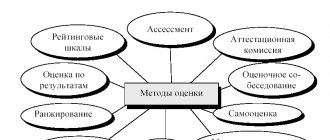What determines the occupational injury frequency rate?
The injury rate allows us to determine the number of tragic incidents at work per 1000 workers. It is usually calculated per year. The formula for the industrial injury rate is not complicated; anyone can handle the calculations. It is important to understand that correctly calculating an indicator is half the battle; it also needs to be analyzed. In the formula you need to substitute data on the number of unfortunate cases that the employer is obliged to record and save.
Calculation formula
The injury frequency rate is determined by the formula:
How to calculate the work injury rate: This will require a clear time frame and correct data. Information on the average number of employees for the period of interest can be obtained from the personnel officer, but it must be applied only to a predetermined period.
Consequences of accidents
Judging by Goskomstat statistics, one of the most noticeable trends in recent years has been the increase in the duration of sick leave for employees injured at work. From 2000 to 2019, this figure increased 1.7 times. So, if in 2000 an injured employee was on sick leave for an average of 28.8 days, then in 2021 this period increased to 50.6 days. Experts say that this situation is due to the simultaneous influence of two factors. On the one hand, the complexity of the mechanisms used increases the severity of injuries suffered by workers. On the other hand, thanks to the efforts of regulatory authorities, statistics on the causes of death of workers at work have become more open, and the rights of workers to sufficient rehabilitation and recovery have become more fully respected.
Compensation expenses
According to current statistics, on average, 10,291 rubles were spent per employee receiving compensation due to industrial injuries in 2019. This figure varied significantly across industries.
Guide: Work Accident
Changes have been made to the Decree of the President of the Russian Federation dated May 6, 2020 N 313, including those concerning the procedure for confirming insured events, upon the occurrence of which an insurance payment is made to certain categories of health workers directly working with patients who are confirmed to have coronavirus.
See Decree of the President of the Russian Federation dated July 30, 2020 N 487. Changes will be taken into account in the material when it is updated. An industrial accident is an event as a result of which an employee died or suffered health damage while performing work duties or work in the interests of the employer (part 1 of article 227 of the Labor Code of the Russian Federation, paragraph 10 of article 3 of Federal Law of July 24, 1998 N 125 -FZ, part 3, clause 3 of the Regulations on the peculiarities of the investigation of accidents, approved by Resolution of the Ministry of Labor of Russia dated October 24, 2002 N 73, hereinafter referred to as the Regulations on the investigation of accidents).
Continue reading in ConsultantPlus
The concept of PT and its analysis
When analyzing PT, the number and degree of damage received by employees while performing their job duties and manager’s assignments are taken into account. PT, of course, is studied not only using the statistical method. After an accident occurs, the Labor Code obliges the manager to create a commission to investigate it.
During the inspections, working conditions at each workplace and the circumstances of the incident are examined in detail. This method of analysis is called monographic. There is also topographical, in the process of application, statistical data for a certain period is established by displaying production on a map. This is how areas of the enterprise that are dangerous for employees are determined.
The injury rate, one or another, can be taken into account when using any method, but adjusted for the purposes of the study, its main methods and periods. For example, it characterizes and demonstrates how things are with PT at an enterprise, in a workshop, at a work site for a certain period of time.
It fulfills its direct purpose only in a statistical method, in which the concept of “occupational injury frequency rate” is widely used - which determines the number of accidents per 1000 workers. That is, it demonstrates the level of PT, but still with an insufficiently high degree of reliability, so it must be taken into account along with other objective data.
Injury Severity Index
Now we will tell you what the relative indicator of injury severity coefficient (CT.t.) determines. The frequency does not indicate the severity of injuries. A situation is possible in which in one organization most of the accidents have a successful outcome, and in another - all cases with severe injuries. Therefore, Kt.t. was introduced, which determines the average number of working days lost by each injured employee during the reporting period (for example, for a quarter, for six months, for a year).
Kt.t. determined by the formula:
Our devices work for you!
Injury risk criteria.
V.M.Popov, Ph.D. technical sciences, director of the Republican Center for Oil and Gas Technical University
When certifying workplaces, ordinal scales are used to assess working conditions. With their help, working conditions are assigned to one class or another, depending on the degree of exposure of the employee to harmful and dangerous factors. With regard to the risk of diseases, such a scale is set by the hygienic classification of working conditions [1], according to which there are optimal (1st class), acceptable (2nd class), harmful (3rd class, four degrees) and extreme (4 th class) working conditions - seven gradations in total. As for the classification of injury hazards, it provides only three gradations [2], without making any distinction between dangerous conditions, regardless of whether there is a high threat of death of the worker or the danger is associated with only the possibility of a minor injury. This circumstance does not allow assessing the risk of injury with the same degree of detail as assessing the risk of disease.
In order to be able to assess the risk of injury and disease with equal accuracy, the classification of injury hazards should be brought into line with the hygienic classification of working conditions, including optimal (1st class), acceptable (2nd class), dangerous (3rd class) class, four degrees) and extreme (4th class) working conditions [3]. At the same time, acceptable, dangerous and extreme working conditions should be characterized by the most severe health consequences that can occur with an unacceptably high probability. Thus, the criterion for assigning working conditions to a certain class and degree of injury risk will be an unacceptably high value of the probability of health damage of the corresponding severity.
Coordination of injury hazard classes with the hygienic classification of working conditions.
According to the hygienic classification [1], working conditions in which there are no harmful factors are considered optimal. Also, optimal conditions from the point of view of the risk of injury should be considered those in which there are no dangerous factors. Of course, conditions may only be optimal for some of the hazards. For example, the danger of chemical burns is eliminated at those production facilities where aggressive liquids are not used.
Acceptable conditions according to the hygienic classification [1] are characterized by the possibility of changing the functional state of the body, which, however, is restored during regulated rest or by the beginning of the next shift. In the same way, by the beginning of the next shift, performance is restored if the employee receives a microtrauma [4]. Consequently, hazard class 2 includes those workplaces in which the likelihood of receiving micro-injuries is high (unacceptable), but at the same time the likelihood of receiving more serious health injuries is very low.
According to the hygienic classification [1], harmful working conditions of the 1st degree of the 3rd class (Z.1c) lead to such functional changes that by the beginning of the next shift the body does not have time to recover to a normal state, i.e. the changes are irreversible. Such consequences can be correlated with mild harm to health caused by injuries, poisoning and other external influences, which leads to temporary disability (up to 21 days inclusive) and in some cases to a slight (less than 10%) permanent loss of general ability to work [5]. Therefore, hazardous working conditions of the 1st degree (3.1o) can be considered those in which there is a high probability of the employee receiving minor injuries (and the probability of receiving more serious injuries is acceptable).
Working in hazardous working conditions of the 2nd degree of the 3rd class causes an increase in the level of morbidity with temporary loss of ability to work and the appearance of initial signs or mild forms of occupational diseases [1]. These consequences are comparable to the consequences of moderate injuries that lead to temporary disability (more than 21 days) or permanent loss of general ability to work (10-30%) [5]. Therefore, hazardous working conditions of the 2nd degree (3.2o) include those in which there is a high probability of causing moderate harm to health (and the probability of more severe health damage is acceptable).
Working conditions of the 3rd degree of the 3rd class of hazard lead to the development of occupational diseases of mild and moderate severity (with loss of professional ability to work) and the growth of chronic (occupation-related) pathology, i.e. to moderate impairment of body functions [1]. Such violations significantly limit the employee’s ability to perform work duties. This manifests itself in a decrease in labor productivity or in a decrease in qualifications, sometimes so pronounced that the employee has to switch to low-skilled work. With such consequences, victims of both occupational diseases and industrial accidents are diagnosed with a loss of professional ability from 40 to 60% [6]. An analysis of the structure of the severity of the consequences of industrial injuries and occupational diseases shows that if 40-50% of the victims lose their professional ability to work, they are recognized as group III disabled [7]. Consequently, dangerous working conditions of the 3rd degree (Z.Zo) include those in which the employee is likely to lose his professional ability to work by 40-60% and become a disabled person of group III, and the probability of receiving more severe health injuries will be acceptably small.
Working conditions of the 4th degree of the 3rd hazard class (3.4c) contribute to the loss of general working capacity due to the occurrence of severe forms of occupational diseases, as well as a significant increase in the number of chronic diseases [1]. With such pronounced impairments of body functions, a person either completely loses professional ability to work, or can only perform work in specially created conditions. Severe injuries that lead to the loss of professional ability to work over 70% [8] and disability of group I or II [7] have the same consequences. Therefore, hazardous working conditions of the 4th degree of the 3rd class (3.4o) can be considered those in which the employee is likely to lose professional ability by more than 70% and become disabled of group I or II, and the probability of receiving a fatal injury will be acceptable small
Extreme working conditions (4th class), according to the hygienic classification, during even one work shift (or part of it) create a threat to life and a high risk of developing acute occupational injuries [1]. The same high threat to life is created by short-term exposure to certain hazardous factors, therefore this definition of extreme working conditions can also be used for class 4 working conditions for the risk of injury.
Limit values of injury probabilities characterizing hazard classes of working conditions.
To implement the regulatory approach used in foreign practice, each class (and degree) of danger of working conditions must be associated with a certain value of unacceptable (or unacceptable) risk. To determine the criteria, you need to refer to injury statistics. According to Rosstat [9], in recent years in Russia the frequency of fatal industrial accidents is about 1x10-4 per year. It should be taken into account that the reliability of injury statistics in the Russian Federation is not high. Thus, according to the International Labor Organization, Russian data on the number of fatal accidents at work are underestimated by more than 1.6 times [10]. Such differences in estimates are explained by the concealment of accidents, including fatalities. If we take into account that even this official figure is 5-10 times higher than similar indicators in the countries of the European Union [8], then we must admit that in Russia the fatal injury rate at work is unacceptably high. Thus, the probability of one person dying at work, equal to 2x10-5 per year (5 times less than the current official figure), should already be considered unacceptable.
It must be taken into account that under extreme conditions several workers can be fatally injured. Such events are characterized by social risk - the dependence of the frequency (probability) of the occurrence of an event F, in which at least N people suffered, on this number N [11]. This dependence is called the F/N curve, although it would be more correct to call it an F/N histogram, since the independent variable is a discrete quantity. Risk is defined as the product of damage and the probability of the event that led to it. Since the minimum unacceptable risk must be the same for the threat of death of any number of people, the minimum unacceptable probability of the simultaneous death of two people should be half as much as the probability of the death of one person, i.e. 1x10-5. Accordingly, the minimum unacceptable probability of the simultaneous death of three people should be three times less than 2x10-5, the probability of the death of four people should be four times less than 2x10-5, etc. The initial section of the F/N histogram, which determines the minimum values of the unacceptable probability for fatal accidents (4th class of working conditions), is shown in Fig. 1. With probability values highlighted in red, work may only be allowed to eliminate accidents, catastrophes, and natural disasters.
Rice. 1. F/N histogram for fatal accidents at work
The minimum values of unacceptable probability for classes Z.Zo and 3.4o can be established using Rosstat data on the number of persons first recognized as disabled due to industrial injuries, Nt.i.i and the number of people employed in the economy [9].
Dynamics of the relative (per 1000 workers) number of persons recognized as disabled for the first time due to occupational injuries, from 2000 to 2009:
| Year | 2000 | 2001 | 2002 | 2003 | 2004 |
| nt.i | 0,17 | 0,17 | 0,15 | 0,13 | 0,13 |
| Year | 2005 | 2006 | 2007 | 2008 | 2009 |
| nt.i | 0,12 | 0,10 | 0,08 | 0,08 | 0,07 |
Statistics show that over the past 10 years, the frequency of recognizing workers as disabled due to work-related injuries has decreased by more than 2 times. If we assume that the values of the indicator at the beginning of the decade are currently no longer acceptable, then the value 1.5-10-4 can serve as a criterion for the unacceptable probability of the initial recognition of workers as disabled due to industrial injuries. Among persons recognized as disabled for the first time due to a work injury or occupational disease, the proportion of group III disabled people is twice as high as the proportion of those workers who were assigned a group I or II disability [7]. Thus, we can accept that the probabilities will be unacceptably high: starting from 1-10-4 - for cases of disability of group III (class Z.Zo); starting from 5x10-5 - for cases of disability of group I or II (class 3.4o).
The number of victims at work who received minor injuries, Nt.l, can be calculated by determining their share in the total number of injured workers who survived, N t.l. To do this, you should use the probability distribution P over the duration of temporary disability at work [12]:
(1)
where i is the number of days of temporary disability; β(t) is a statistical indicator that depends on the size of the team, the number of workers with temporary disability and the total duration of temporary disability. To determine the proportion of workers who received minor injuries, you need to calculate the function F of the probability distribution of disability up to 21 days:
(2)
Calculations of the statistical indicator β (t) based on data on temporary disability in various industries and for different professions show that its values range from 0.08 to 0.1 [12]. Accordingly, the values of F(i≤21), calculated using formula (2), vary from 0.75 to 0.79. When setting criteria, one should be guided by the lower of these two values, which corresponds to the worst structure of injuries of varying severity, i.e. accept Nt.l. = 0.75Nt.f. Determine Nt.zh. can be, using Rosstat data [9], as the difference between the total number of victims in industrial accidents and the number of victims in fatal industrial accidents.
The number of victims at work who received injuries of moderate severity, N, can be easily found by subtracting the values of Nt.i and Nt.l from Nt.zh..
The results of calculating the relative (per 1000 workers) number of victims at work who received minor injuries nt.s. and moderate injuries nt.s. , from 2000 to 2009:
| Year | 2000 | 2001 | 2002 | 2003 | 2004 |
| nt.l | 3,71 | 3,64 | 3,27 | 2,83 | 2,45 |
| nt.s | 1,07 | 1,04 | 0,94 | 0,81 | 0,69 |
| Year | 2005 | 2006 | 2007 | 2008 | 2009 |
| nt.l | 2,23 | 2,09 | 1,93 | 1,79 | 1,51 |
| nt.s | 0,62 | 0,60 | 0,56 | 0,52 | 0,43 |
Taking into account that the values of these indicators at the beginning of the decade are unacceptably high, the criteria for unacceptable probabilities of minor injuries and moderate injuries can be the values 3x10-3 (class 3.1o) and 1x10-3 (class 3.2o), respectively.
In accordance with the ALARA1 principle, work in hazardous working conditions (class 3) may be allowed in cases where it is impossible to reduce the risk with modern developments of technology or unreasonably large costs are required to reduce it to acceptable values. It is known that the frequency of microtraumas received by workers is 10 times higher than the frequency of minor injuries [13], therefore, the minimum unacceptable probability of microtraumas characterizing acceptable working conditions (class 2o) should be considered 3x10-2.
In Fig. Table 2 presents the unacceptable probabilities of damage to the health of the Republic of Kazakhstan proposed as criteria for the injury hazard scale. The area of unacceptable (excessive) individual risk is highlighted in red. The orange color corresponds to that part of the ALARA zone in which reducing individual risk is practically unattainable or the costs of reducing it far exceed the resulting gain. Yellow color is part of the ALARA zone, in which reducing individual risk is, in principle, possible, but the benefits obtained from this still do not cover the costs of the employer. Green color indicates a completely acceptable individual risk, when there is no need to use the ALARA principle [14].
Application of the proposed classification of injury hazards will make it possible to create more accurate methods for assessing the injury hazard of workplaces in comparison with the methodology set out in the document [2]. Thus, the prerequisites will appear for overcoming the long-term stagnation in this area - after all, the recently approved methodology [2] differs only in extreme brevity from the old one [15], adopted back in 1999.
Rice. 2. Injury risk criteria: hazard classes: 2 - microtrauma, 3.1 - mild injury, 3.2 - moderate injury, 3.3 - disability group III, 3.4 - disability group II or I, 4 - death
1 The ALARA or ALARP principle (As Low As Reasonably Applicable (Practicable)) is an approach to risk management that implies its maximum possible reduction, achievable using actually available (limited) resources.
Bibliography.
1. R 2.2.2006—05. Guidelines for hygienic assessment of working environment and labor process factors. Criteria and classification of working conditions // Bulletin of normative and methodological documents of the State Sanitary and Epidemiological Supervision. — 2005. — No. 3. 2. The procedure for certification of workplaces according to working conditions // Ros. gas. - No. 5511. - 2011. - June 24. 3. Popov V.M. Assessing occupational risk in the workplace // Occupational safety in industry. - 2010. -No. 7. -S. 68-71. 4. Kotik M.A. Psychology and safety. - Tallinn: Valgus, 1989. - 448 p. 5. Medical criteria for determining the severity of harm caused to human health // Ros. gas. - No. 188 (4754). — 2008. — September 5. 6. Rules for establishing the degree of loss of professional ability to work as a result of industrial accidents and occupational diseases // Collection. legislation of Russia. Federation. - 2000. - No. 43. - Art. 4247. 7. Insurance against industrial accidents: actuarial principles// V.N. Baskakov, O.N. Andreeva, M.E. Baskakova and others; Ed. V.N. Baskakova. - M.: Academy, 2001. - 192 p. 8. Pankov V., Mikhina T. Industrial injuries: decreasing or increasing? // Security there and social insurance. - 2007. - No. 1. - P. 38-42. 9. Russian statistical yearbook. 2010: Collection / Rosstat. - M.: Statistics of Russia, 2010. - 813 p. 10. Rusak O. Labor protection as a “black box” // Labor protection and social insurance. - 2007. - No. 10. - P. 28-32. 11. RD 03-418—01. Guidelines for conducting risk analysis of hazardous production facilities. — Ser. 03. - Issue. 10. - M.: Scientific and Technical Center "Industrial Safety", 2004. - 40 p. 12. Fedorovich G. Statistical ensembles of temporary disability // Man and labor. - 2011. - No. 3.-S. 57-61. 13. Karnaukh P., Karnaukh M. New principles in the management of labor protection in organizations // Labor protection and social insurance. - 2002. - No. 3. - P. 17-21. 14. Bykov A.A., Akimov V.A., Faleev M.I. Regulatory and economic models of risk management // Problems of risk analysis. - 2004. - No. 2. - P. 125-137. 15. MUOTRM02—99. Assessing the safety of workplaces for the purposes of their certification for working conditions. - M.: Aprokhim, 1999. - 137 p.
LTIFR - injury frequency rate
In addition to the above coefficients, one of the most important indicators of health status used in world practice is the Lost Time Injury Frequency Rate (or abbreviated LTIFR). It reflects the frequency of injuries resulting in disability. It also represents the ratio of the number of cases of loss of working time and the total amount of time worked in the organization for the reporting year, normalized by 1 million people/hour:
LTIFR = total work time lost as a result of injuries × 1 million man-hours / total work time worked.
An example of calculating the industrial injury rate and evaluating the results
Let's consider an example: 200 workers worked in logging production in 2020. During this period, five people were injured while performing their job duties. As a result, employees became temporarily unable to work. We make the calculation according to the formula CN = T / P × 1000. Substitute the numbers:
CN = 5 / 200 × 1000 = 25.
The principle and rules for calculating this indicator are clear. The formula is simple, you just need to substitute the numbers in the correct order. Of course, a figure obtained once is not very informative. It is necessary to have reports for several years to study the dynamics. For example, by collecting data, an employer will be able to understand whether employees have become less injured after he introduced new equipment into production. Or did the situation remain unchanged? It is also worth considering that for a more serious analysis other indicators may be required, since CT alone does not provide sufficient data for meaningful conclusions.










